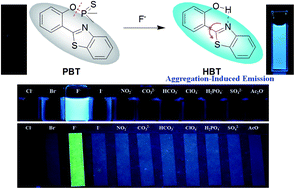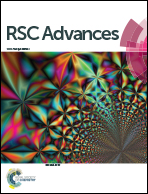A “Turn-On” fluorescent probe for sensitive and selective detection of fluoride ions based on aggregation-induced emission†
Abstract
Based on the fluorophore of 2-(2′-hydroxyphenyl)benzothiazole (HBT) with aggregation-induced emission (AIE) properties, a highly selective and sensitive fluorescent probe PBT towards F− was investigated. “Turn-On” fluorescence type signaling was realized by employing fluoride-selective cleavage of the latent thiophosphinated probe in mixed aqueous media. The probe is designed in such a way that the excited state intramolecular proton transfer (ESIPT) of the HBT moiety becomes blocked. The chemodosimetric approach of F− to the probe results in the recovery of the ESIPT by removal of a free AIE-active HBT moiety through a subsequent hydrolysis process. The F− detection limit of the probe was 3.8 nM in the dynamic range of 0.5 μM to 10 μM. In addition, the proposed probe has been used to detect F− in water samples and toothpaste samples with satisfying results.

- This article is part of the themed collection: Editors’ collection: Fluorescent Sensors


 Please wait while we load your content...
Please wait while we load your content...